12 aug 2017
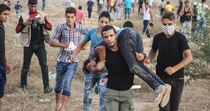
6 Palestinians were injured Friday evening after being attacked by the Israeli occupation forces (IOF) east of al-Bureij refugee camp and Jabalia town in the Gaza Strip.
Spokesman of the Gaza Ministry of Health, Ashraf al-Qedra, said that medical crews treated 5 injuries east of Jabalia and one injury east of al-Bureij.
Earlier, the PIC reporter said that the IOF soldiers deployed behind the security fence east of the Gaza Strip fired live bullets and tear gas canisters at the Palestinian youths demonstrating in the area.
Qedra reported that two minors aged 16 and 17 were shot in the head and leg respectively, describing the head injury as serious.
The area close to the fence separating the Gaza Strip and the 1948 occupied Palestinian territories witnesses regular demonstrations, especially on Fridays, protesting tightening the siege imposed on Gaza.
Spokesman of the Gaza Ministry of Health, Ashraf al-Qedra, said that medical crews treated 5 injuries east of Jabalia and one injury east of al-Bureij.
Earlier, the PIC reporter said that the IOF soldiers deployed behind the security fence east of the Gaza Strip fired live bullets and tear gas canisters at the Palestinian youths demonstrating in the area.
Qedra reported that two minors aged 16 and 17 were shot in the head and leg respectively, describing the head injury as serious.
The area close to the fence separating the Gaza Strip and the 1948 occupied Palestinian territories witnesses regular demonstrations, especially on Fridays, protesting tightening the siege imposed on Gaza.
11 aug 2017
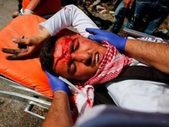
Two Palestinian juveniles were injured Friday evening east of al-Bureij refugee camp and Jabalya town in Gaza Strip.
The PIC reporter said that Israeli Occupation Forces (IOF) at the security border fence east of Gaza Strip opened their gunfire and unleashed tear gas grenades at a group of Palestinian youths who were gathering near the fence. Two young men aged 16 and 17 years were shot in the head and leg respectively.
The injury in the head was very serious while the other was moderate, the spokesman of the Palestinian Health Ministry Ashraf al-Qudra said.
The Gaza border area with 1948 Occupied Palestine usually witnesses clashes and demonstrations in protest at the continuation of the Israeli decade-long siege on Gaza especially on Fridays.
Army Injures Several Palestinians, Including A Teen In Serious Condition, In Gaza
Israeli soldiers shot and injured, Friday, many young Palestinian men, including a teenager who suffered life-threatening wounds, during clashes that took place in several parts of the besieged Gaza Strip.
Medical sources said a teenage boy, 16 years of age, suffered a serious injury after the soldiers, stationed across the border fence, shot him with a gas bomb in the head, during clashes that took place in Jabalia, in the northern part of the Gaza Strip.
The sources added that the soldiers also targeted several ambulances and medics, during their attempts to provide aid to wounded Palestinians.
Furthermore, two young men suffered moderate wounds during clashes that took place east of the al-Boreij refugee camp, in central Gaza, after the soldiers opened fire on Palestinian protesters.
More clashes took place between the soldiers, also across the border fence, near Nahal Oz military base, when the army fired many live rounds at the protesters, wounding two young men in their legs, before medics rushed them to the Shifa medical center, suffering moderate wounds.
The PIC reporter said that Israeli Occupation Forces (IOF) at the security border fence east of Gaza Strip opened their gunfire and unleashed tear gas grenades at a group of Palestinian youths who were gathering near the fence. Two young men aged 16 and 17 years were shot in the head and leg respectively.
The injury in the head was very serious while the other was moderate, the spokesman of the Palestinian Health Ministry Ashraf al-Qudra said.
The Gaza border area with 1948 Occupied Palestine usually witnesses clashes and demonstrations in protest at the continuation of the Israeli decade-long siege on Gaza especially on Fridays.
Army Injures Several Palestinians, Including A Teen In Serious Condition, In Gaza
Israeli soldiers shot and injured, Friday, many young Palestinian men, including a teenager who suffered life-threatening wounds, during clashes that took place in several parts of the besieged Gaza Strip.
Medical sources said a teenage boy, 16 years of age, suffered a serious injury after the soldiers, stationed across the border fence, shot him with a gas bomb in the head, during clashes that took place in Jabalia, in the northern part of the Gaza Strip.
The sources added that the soldiers also targeted several ambulances and medics, during their attempts to provide aid to wounded Palestinians.
Furthermore, two young men suffered moderate wounds during clashes that took place east of the al-Boreij refugee camp, in central Gaza, after the soldiers opened fire on Palestinian protesters.
More clashes took place between the soldiers, also across the border fence, near Nahal Oz military base, when the army fired many live rounds at the protesters, wounding two young men in their legs, before medics rushed them to the Shifa medical center, suffering moderate wounds.
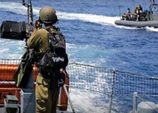
Israeli navy ships attacked, on Friday at dawn, several Palestinian fishing boats in Gaza territorial waters, abducted two fishermen, and confiscated their boat.
Eyewitnesses said the navy fired dozens of live rounds the fishing boats, confiscated a small boat, and abducted two fishermen, identified as Saddam Abdul-Bari Sultan, 22, and his brother Odai, 25.
The navy cuffed the two fishers, and took them, along with the small boat, to an unknown destination.
Eyewitnesses said the navy fired dozens of live rounds the fishing boats, confiscated a small boat, and abducted two fishermen, identified as Saddam Abdul-Bari Sultan, 22, and his brother Odai, 25.
The navy cuffed the two fishers, and took them, along with the small boat, to an unknown destination.
9 aug 2017
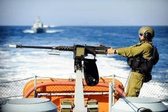
Israeli occupation gunboats targeted, last night, fishing boats off the shores of Khan Younis and Deir al-Balah, in the south and central Gaza Strip, with heavy machine guns.
Al Ray reports that, according to local sources, the military boats targeted fishermen’s boats while they were fishing at sea, within the allowed fishing distance of 6 nautical miles.
Israeli occupation forces routinely attack Gazan fishermen and their fishing boats in the context of Israel’s closure of the Gaza Strip, which includes restrictions on the Gaza fishing zone that deprive members of the community of their right to work, and puts fishermen’s life and well being at serious risk.
The attacks include violations on the right to livelihood, harassment and shooting, arbitrary arrest and detention that involves abuse, and confiscation of property including fishing boats and nets.
Israeli forces use cruel, inhumane and degrading punishments during detentions. In 2013, the army carried out 147 attacks against fishermen, injuring 10, arresting 22, confiscating 9 boats, and destroying extensive amounts of fishing equipment.
Al Ray reports that, according to local sources, the military boats targeted fishermen’s boats while they were fishing at sea, within the allowed fishing distance of 6 nautical miles.
Israeli occupation forces routinely attack Gazan fishermen and their fishing boats in the context of Israel’s closure of the Gaza Strip, which includes restrictions on the Gaza fishing zone that deprive members of the community of their right to work, and puts fishermen’s life and well being at serious risk.
The attacks include violations on the right to livelihood, harassment and shooting, arbitrary arrest and detention that involves abuse, and confiscation of property including fishing boats and nets.
Israeli forces use cruel, inhumane and degrading punishments during detentions. In 2013, the army carried out 147 attacks against fishermen, injuring 10, arresting 22, confiscating 9 boats, and destroying extensive amounts of fishing equipment.
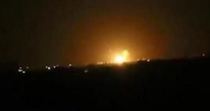
The Israeli war planes carried out Tuesday evening a number of airstrikes, targeting different areas northern and western the besieged Gaza Strip.
The PIC reporter affirmed that two resistance sites, belonging to Hamas’ armed wing, were targeted during the air raids.
At least three injuries were reported during Tuesday night’s strikes.
The injured were immediately taken to hospital, one of them in very critical condition as he was hit in his head by a shrapnel.
Earlier Tuesday, Israeli army claimed that a rocket, fired from Gaza Strip, landed southern Israel. No casualties or damage were reported from the rocket strike.
Army Injures Seven Palestinians In Gaza
The Israeli Air Force fired missiles, on Wednesday at dawn, into several areas, west of Gaza city and Beit Lahia, in the northern part of the besieged and improvised Gaza Strip, wounding at least seven Palestinians, including one who suffered a serious injury.
Medical sources said the soldiers injured seven Palestinians, including one who suffered life-threatening wounds, after the army fired missiles into two areas northwest of the Gaza Strip. The attack also led to excessive damage to several homes and structures near the targeting sites.
The sources added that all wounded Palestinians were moved to the Shifa Medical Center, west of Gaza city, and that one of the injured remains in a critical condition.
In addition, the air force also fired missiles into a site, north of Beit Lahia, in the northern part of the Gaza Strip, causing excessive damage to the building, and several surrounding homes.
In a statement, the Israeli army said that the attacks came in response to a homemade shell which was fired from Gaza into the Hof Ashkelon Regional Council, during late night hours, but landed in an open area, causing no damage or injuries.
The PIC reporter affirmed that two resistance sites, belonging to Hamas’ armed wing, were targeted during the air raids.
At least three injuries were reported during Tuesday night’s strikes.
The injured were immediately taken to hospital, one of them in very critical condition as he was hit in his head by a shrapnel.
Earlier Tuesday, Israeli army claimed that a rocket, fired from Gaza Strip, landed southern Israel. No casualties or damage were reported from the rocket strike.
Army Injures Seven Palestinians In Gaza
The Israeli Air Force fired missiles, on Wednesday at dawn, into several areas, west of Gaza city and Beit Lahia, in the northern part of the besieged and improvised Gaza Strip, wounding at least seven Palestinians, including one who suffered a serious injury.
Medical sources said the soldiers injured seven Palestinians, including one who suffered life-threatening wounds, after the army fired missiles into two areas northwest of the Gaza Strip. The attack also led to excessive damage to several homes and structures near the targeting sites.
The sources added that all wounded Palestinians were moved to the Shifa Medical Center, west of Gaza city, and that one of the injured remains in a critical condition.
In addition, the air force also fired missiles into a site, north of Beit Lahia, in the northern part of the Gaza Strip, causing excessive damage to the building, and several surrounding homes.
In a statement, the Israeli army said that the attacks came in response to a homemade shell which was fired from Gaza into the Hof Ashkelon Regional Council, during late night hours, but landed in an open area, causing no damage or injuries.
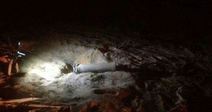
A rocket landed in an open area in Ashkelon city in southern Israel on Tuesday evening, causing no injuries.
An Israeli army spokesperson claimed that the rocket had been fired from the besieged Gaza Strip.
Red alert sirens were sounded as the rocket fell in the city.
Israeli forces were sweeping the area looking for any rocket landed in the area.
An Israeli army spokesperson claimed that the rocket had been fired from the besieged Gaza Strip.
Red alert sirens were sounded as the rocket fell in the city.
Israeli forces were sweeping the area looking for any rocket landed in the area.
6 aug 2017
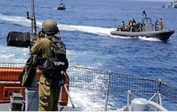
The Israeli navy, Sunday morning, fired at Palestinian fishermen in their boats, as they were sailing off al-Sudaniya shore, north of the Gaza Strip, local sources said.
According to WAFA correspondence, the attack caused damage to the boats, but no casualties were reported among the fishermen, who fled the sea in fear of arrest or harm.
Despite the signed agreements with Israel, which allow fishermen to sail as far as 12 nautical miles, Israeli navy targets Gaza’s fishermen on daily basis, and doesn’t allow them to go further than three nautical miles, which is not enough as fish is not dense.
PNN further reports that, according to local sources in Gaza, Israeli naval boats fired both shells and heavy machine-gun fire at the boats.
At least one fishing boat was damaged.
Israeli forces, on Sunday, also detained a young man near the border fence to the north of Beit Lahia town, in the northern Gaza Strip. He was taken to an unknown destination.
Soldiers also opened heavy machine gun fire towards farmers’ lands and residential homes in the area. No injuries were reported.
According to WAFA correspondence, the attack caused damage to the boats, but no casualties were reported among the fishermen, who fled the sea in fear of arrest or harm.
Despite the signed agreements with Israel, which allow fishermen to sail as far as 12 nautical miles, Israeli navy targets Gaza’s fishermen on daily basis, and doesn’t allow them to go further than three nautical miles, which is not enough as fish is not dense.
PNN further reports that, according to local sources in Gaza, Israeli naval boats fired both shells and heavy machine-gun fire at the boats.
At least one fishing boat was damaged.
Israeli forces, on Sunday, also detained a young man near the border fence to the north of Beit Lahia town, in the northern Gaza Strip. He was taken to an unknown destination.
Soldiers also opened heavy machine gun fire towards farmers’ lands and residential homes in the area. No injuries were reported.
3 aug 2017
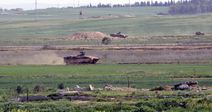
Israeli military bulldozers launched a limited incursion into eastern Khuza’a town, south of the blockaded Gaza Strip, on Thursday morning.
According to local sources, five Israeli military bulldozers, moved some 50 meters into eastern Khuza’a town, to the east of Khan Younis city.
The Israeli vehicles leveled Palestinian land lots near the border fence. At the same time, a flock of Israeli army vehicles have been deployed on the borderland.
According to local sources, five Israeli military bulldozers, moved some 50 meters into eastern Khuza’a town, to the east of Khan Younis city.
The Israeli vehicles leveled Palestinian land lots near the border fence. At the same time, a flock of Israeli army vehicles have been deployed on the borderland.
2 aug 2017
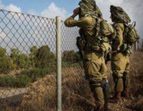
Israeli soldiers opened fire, earlier Wednesday, into Palestinian agricultural lands, east of Rafah, in the southern part of the Gaza Strip, and abducted two Palestinians. The army also abducted one Palestinian in Ramallah, in central West Bank.
Eyewitnesses said the soldiers fired many live rounds into the agricultural lands, close to the border fence, east of Rafah, and abducted two Palestinians for “approaching the fence.”
The two were cuffed and blindfolded before the soldiers moved them to an unknown destination.
Israel prevents the Palestinians from entering their owned lands, in all areas close to the border fence, in the northern and eastern parts of the Gaza Strip, in addition to frequently invading and bulldozing the lands.
In the West Bank, the soldiers invaded the al-Masayef area, in Ramallah, and abducted Yazeed Rajeh Rimawi, 38, from his home after violently searching it.
The abducted man is originally from Beit Rima town, northwest of Ramallah.
Eyewitnesses said the soldiers fired many live rounds into the agricultural lands, close to the border fence, east of Rafah, and abducted two Palestinians for “approaching the fence.”
The two were cuffed and blindfolded before the soldiers moved them to an unknown destination.
Israel prevents the Palestinians from entering their owned lands, in all areas close to the border fence, in the northern and eastern parts of the Gaza Strip, in addition to frequently invading and bulldozing the lands.
In the West Bank, the soldiers invaded the al-Masayef area, in Ramallah, and abducted Yazeed Rajeh Rimawi, 38, from his home after violently searching it.
The abducted man is originally from Beit Rima town, northwest of Ramallah.
31 july 2017

by Nathan Thrall
When violence erupts in Jerusalem and the West Bank, it is usually not long before the Gaza Strip follows. At Gaza’s border with Israel on Friday, a Palestinian teenager was killed while protesting in solidarity with Palestinians in Jerusalem. Several days earlier, two rockets were fired at Israel from Gaza, and the next day Israeli tanks destroyed a Hamas position.
It’s an all-too-familiar echo of the events that preceded the Gaza conflict of 2014: widespread Palestinian protests in Jerusalem, Israelis murdered in the occupied territories, a sharp rise in Palestinians killed by Israeli forces, mass arrests of Hamas officials in the West Bank, and a steadily tightening noose around Gaza.
In February, Israel’s state comptroller released a report that strongly criticized the government’s failure to prevent the 2014 conflict. The report highlighted a statement made by Defense Minister Moshe Yaalon days after the war began: “If Hamas’s distress had been addressed a few months ago, Hamas might have avoided the current escalation.”
The population of Gaza is now suffering far more than it was before the 2014 eruption. Once again, the three parties responsible for the blockade causing that distress — Israel, Egypt and the Palestinian Authority — are bringing the next war closer.
The 2014 violence was precipitated by a change in Egyptian policy: Upon taking power in July 2013, President Abdel Fattah el-Sisi of Egypt closed his country’s sole border crossing with Gaza for long periods and shut nearly all of the tunnels that had smuggled in fuel and other goods that the Gaza government taxed. Starved of revenue, the Hamas-led government could not sustain itself. In desperation, Hamas agreed to hand administrative responsibility to a Palestinian Authority government that was dominated by the rival Fatah party.
But the new government changed little for Gazans: civil servants remained unpaid, most residents were trapped inside the territory and spent half their days without electricity. A new war — leading, as in November 2012, to a new cease-fire deal easing restrictions on Gaza — was seen as the only way out.
Today, it is the Palestinian Authority worsening Gaza’s distress. In recent months, the Authority has conditioned the supply of fuel to the Strip on the payment of a large tax; severely cut compensation to Palestinian Authority employees in Gaza; reduced payments to Israel for providing Gaza’s electricity; prevented large numbers of patients from receiving treatment outside the territory; forced thousands of Gaza government employees into early retirement; barred Gaza banks from transferring payments to Egypt in order to obtain fuel for the Strip’s only power plant; and threatened to cut off welfare payments to some 80,000 families.
The result has been a humanitarian catastrophe. Gaza is on the verge of collapse. Electricity is in short supply, water is undrinkable and raw sewage is being dumped in the sea. Patients denied transfers out of Gaza have died.
The crisis has awoken some Israeli analysts and policy makers to the increased risk of a new conflict. In late April, Giora Eiland, a national security adviser under former Prime Minister Ariel Sharon, warned that the Palestinian Authority “is pushing Hamas to take the only option they have and this is to open fire on Israel and attract again the attention of the international community.” He added: “The P.A. wants to make the situation in Gaza as poor as possible in order for Fatah to succeed against Hamas. So both the people of Israel and of Gaza are going to pay the price of the P.A.’s cynical political game.”
But the Palestinian Authority is not the only, or even primary, party to blame. The real basis of Gaza’s problems lies in Israeli and Egyptian moves to isolate Gaza, as well as in Israel’s and the international community’s decision to uphold the fiction that the Palestinian Authority controls the territory and should therefore be entitled to tax its goods and receive and administer its aid.
For 10 years, Israel and most of the international community have sought to weaken Gaza’s rulers by pretending they don’t exist. Israel collects taxes on all the goods it sends into Gaza and transfers that money to the Palestinian Authority, knowing full well that the Authority spends most of it not on services for Gaza but on the Palestinian Authority’s former employees there, who for a decade have been paid to stay home in order to cripple the Hamas-led government.
To compensate its own employees and cover its operating expenses, the Gaza government had relied on taxing goods that came through the Sinai smuggling tunnels. Unlike goods that enter from Israel, these did not arrive with price tags inflated by taxes that went to the Palestinian Authority. When the tunnels were almost entirely closed by Egypt in 2013, the amount of goods entering Gaza from Israel greatly increased. Gazans were now doubly taxed on many imports — first by the Palestinian Authority, before the goods entered the territory, then by the Gaza government.
While the switch to goods from Israel put an extra burden on the people living in Gaza, it was a boon to the Palestinian Authority’s coffers. But instead of spending more on the Strip, the Authority started to spend less, hoping to bring an already weakened Hamas to its knees. Meanwhile, the international community helped uphold this unjust system, refusing to engage with the Gaza government and instead directing much of the budgetary aid that was ostensibly intended for the people of Gaza — roughly 40 percent of Palestinians in the occupied territories — to the Palestinian Authority.
To stabilize Gaza, Egypt has begun to allow in some fuel. That is a positive first step. But much more needs to be done, above all changing the system in which the people of Gaza are taxed by a government that not only does not represent them but is actively seeking to do them harm.
This can be achieved in three ways. First, Israel — which refuses to engage with any Hamas-led government — could transfer tax revenues on Gaza-bound goods to the people of Gaza, either through an internationally supervised trust or by using the tax revenues to pay for increased electricity. Second, Egypt could export more goods to Gaza, thereby reducing the amount taxed by Israel and increasing the amount taxed directly by Gaza’s government. Third, Hamas could allow the formation of a new administrative body in Gaza, led by a non-Hamas figure, in which case Israel and the international community could engage with it directly to improve life in Gaza and establish a long-term cease-fire.
The objection to any of these options in Ramallah — beyond the blow to the Palestinian Authority’s budget — is that they would deepen the separation of the West Bank and the Gaza Strip and sound the death knell for the Palestinian national movement. (The irony of the Palestinian Authority warning against division as it chokes Gaza seems to be lost in Ramallah.) Some in Gaza have a similar concern: that changes to its status could leave the territory even more vulnerable if they required it to rely on a single lifeline to the outside world through Egypt, which might act even more harshly and with greater impunity in the event of, for instance, another attack near Gaza’s border in Sinai.
But fear of potential consequences should not lead to the perpetuation of harm and the disregard of imminent threat. In the foreseeable future, a new Gaza-Israel conflict, and another after that, are much more likely than bridging the West Bank-Gaza rift. The easiest and most sustainable way to head off that even more catastrophic future is for the goods consumed by two million people in Gaza to be taxed solely by the government that serves them.
- Nathan Thrall, a senior analyst at the International Crisis Group, is the author of “The Only Language They Understand: Forcing Compromise in Israel and Palestine.” Robert Blecher is senior adviser and acting Middle East and North Africa director at the International Crisis Group.
The article was published in the New York Times.
When violence erupts in Jerusalem and the West Bank, it is usually not long before the Gaza Strip follows. At Gaza’s border with Israel on Friday, a Palestinian teenager was killed while protesting in solidarity with Palestinians in Jerusalem. Several days earlier, two rockets were fired at Israel from Gaza, and the next day Israeli tanks destroyed a Hamas position.
It’s an all-too-familiar echo of the events that preceded the Gaza conflict of 2014: widespread Palestinian protests in Jerusalem, Israelis murdered in the occupied territories, a sharp rise in Palestinians killed by Israeli forces, mass arrests of Hamas officials in the West Bank, and a steadily tightening noose around Gaza.
In February, Israel’s state comptroller released a report that strongly criticized the government’s failure to prevent the 2014 conflict. The report highlighted a statement made by Defense Minister Moshe Yaalon days after the war began: “If Hamas’s distress had been addressed a few months ago, Hamas might have avoided the current escalation.”
The population of Gaza is now suffering far more than it was before the 2014 eruption. Once again, the three parties responsible for the blockade causing that distress — Israel, Egypt and the Palestinian Authority — are bringing the next war closer.
The 2014 violence was precipitated by a change in Egyptian policy: Upon taking power in July 2013, President Abdel Fattah el-Sisi of Egypt closed his country’s sole border crossing with Gaza for long periods and shut nearly all of the tunnels that had smuggled in fuel and other goods that the Gaza government taxed. Starved of revenue, the Hamas-led government could not sustain itself. In desperation, Hamas agreed to hand administrative responsibility to a Palestinian Authority government that was dominated by the rival Fatah party.
But the new government changed little for Gazans: civil servants remained unpaid, most residents were trapped inside the territory and spent half their days without electricity. A new war — leading, as in November 2012, to a new cease-fire deal easing restrictions on Gaza — was seen as the only way out.
Today, it is the Palestinian Authority worsening Gaza’s distress. In recent months, the Authority has conditioned the supply of fuel to the Strip on the payment of a large tax; severely cut compensation to Palestinian Authority employees in Gaza; reduced payments to Israel for providing Gaza’s electricity; prevented large numbers of patients from receiving treatment outside the territory; forced thousands of Gaza government employees into early retirement; barred Gaza banks from transferring payments to Egypt in order to obtain fuel for the Strip’s only power plant; and threatened to cut off welfare payments to some 80,000 families.
The result has been a humanitarian catastrophe. Gaza is on the verge of collapse. Electricity is in short supply, water is undrinkable and raw sewage is being dumped in the sea. Patients denied transfers out of Gaza have died.
The crisis has awoken some Israeli analysts and policy makers to the increased risk of a new conflict. In late April, Giora Eiland, a national security adviser under former Prime Minister Ariel Sharon, warned that the Palestinian Authority “is pushing Hamas to take the only option they have and this is to open fire on Israel and attract again the attention of the international community.” He added: “The P.A. wants to make the situation in Gaza as poor as possible in order for Fatah to succeed against Hamas. So both the people of Israel and of Gaza are going to pay the price of the P.A.’s cynical political game.”
But the Palestinian Authority is not the only, or even primary, party to blame. The real basis of Gaza’s problems lies in Israeli and Egyptian moves to isolate Gaza, as well as in Israel’s and the international community’s decision to uphold the fiction that the Palestinian Authority controls the territory and should therefore be entitled to tax its goods and receive and administer its aid.
For 10 years, Israel and most of the international community have sought to weaken Gaza’s rulers by pretending they don’t exist. Israel collects taxes on all the goods it sends into Gaza and transfers that money to the Palestinian Authority, knowing full well that the Authority spends most of it not on services for Gaza but on the Palestinian Authority’s former employees there, who for a decade have been paid to stay home in order to cripple the Hamas-led government.
To compensate its own employees and cover its operating expenses, the Gaza government had relied on taxing goods that came through the Sinai smuggling tunnels. Unlike goods that enter from Israel, these did not arrive with price tags inflated by taxes that went to the Palestinian Authority. When the tunnels were almost entirely closed by Egypt in 2013, the amount of goods entering Gaza from Israel greatly increased. Gazans were now doubly taxed on many imports — first by the Palestinian Authority, before the goods entered the territory, then by the Gaza government.
While the switch to goods from Israel put an extra burden on the people living in Gaza, it was a boon to the Palestinian Authority’s coffers. But instead of spending more on the Strip, the Authority started to spend less, hoping to bring an already weakened Hamas to its knees. Meanwhile, the international community helped uphold this unjust system, refusing to engage with the Gaza government and instead directing much of the budgetary aid that was ostensibly intended for the people of Gaza — roughly 40 percent of Palestinians in the occupied territories — to the Palestinian Authority.
To stabilize Gaza, Egypt has begun to allow in some fuel. That is a positive first step. But much more needs to be done, above all changing the system in which the people of Gaza are taxed by a government that not only does not represent them but is actively seeking to do them harm.
This can be achieved in three ways. First, Israel — which refuses to engage with any Hamas-led government — could transfer tax revenues on Gaza-bound goods to the people of Gaza, either through an internationally supervised trust or by using the tax revenues to pay for increased electricity. Second, Egypt could export more goods to Gaza, thereby reducing the amount taxed by Israel and increasing the amount taxed directly by Gaza’s government. Third, Hamas could allow the formation of a new administrative body in Gaza, led by a non-Hamas figure, in which case Israel and the international community could engage with it directly to improve life in Gaza and establish a long-term cease-fire.
The objection to any of these options in Ramallah — beyond the blow to the Palestinian Authority’s budget — is that they would deepen the separation of the West Bank and the Gaza Strip and sound the death knell for the Palestinian national movement. (The irony of the Palestinian Authority warning against division as it chokes Gaza seems to be lost in Ramallah.) Some in Gaza have a similar concern: that changes to its status could leave the territory even more vulnerable if they required it to rely on a single lifeline to the outside world through Egypt, which might act even more harshly and with greater impunity in the event of, for instance, another attack near Gaza’s border in Sinai.
But fear of potential consequences should not lead to the perpetuation of harm and the disregard of imminent threat. In the foreseeable future, a new Gaza-Israel conflict, and another after that, are much more likely than bridging the West Bank-Gaza rift. The easiest and most sustainable way to head off that even more catastrophic future is for the goods consumed by two million people in Gaza to be taxed solely by the government that serves them.
- Nathan Thrall, a senior analyst at the International Crisis Group, is the author of “The Only Language They Understand: Forcing Compromise in Israel and Palestine.” Robert Blecher is senior adviser and acting Middle East and North Africa director at the International Crisis Group.
The article was published in the New York Times.

The Israeli gunboats on Monday opened fire at Palestinian fishing boats sailing off al-Sudaniya coast, north of the blockaded Gaza Strip.
According to local sources, the Israeli navy unleashed heavy machinegun fire off al-Sudaniya coast.
No injuries were reported in the shooting attack.
The attack represents a flagrant violation of the Cairo-brokered ceasefire accord struck in the wake of the 2014 offensive on the besieged coastal enclave of Gaza.
According to local sources, the Israeli navy unleashed heavy machinegun fire off al-Sudaniya coast.
No injuries were reported in the shooting attack.
The attack represents a flagrant violation of the Cairo-brokered ceasefire accord struck in the wake of the 2014 offensive on the besieged coastal enclave of Gaza.
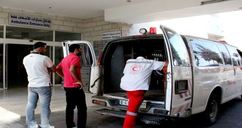
Two Palestinians, including a 13-year-old child, suffered different injuries Sunday evening by the explosion of a suspicious object from the Israeli forces’ remnants east of Khan Younis to the south of Gaza Strip.
According to the PIC reporter, the two were moderately injured and they were both taken to hospital for treatment.
Many Palestinians, especially children, have been injured and killed in different areas of occupied Palestine by unexploded ordnance of Israeli army.
According to the PIC reporter, the two were moderately injured and they were both taken to hospital for treatment.
Many Palestinians, especially children, have been injured and killed in different areas of occupied Palestine by unexploded ordnance of Israeli army.
Truce violations List of names Pictures of martyrs
Days: Aug: 26 - 25 - 24 - 23 - 22 - 21 - 20 - 19 - 18 - 17 - 16 - 15 - 14 - 13 - 12 - 11 - 10 - 9 - 8 - 7 - 6 - 5 - 4 - 3 - 2 - 1
July: 31 - 30 - 29 - 28 - 27 - 26 - 25 - 24 - 23 - 22 - 21 - 20 - 19 - 18 - 17 - 16 - 15 - 14 - 13 - 12 - 11 - 10 - 9 - 8
